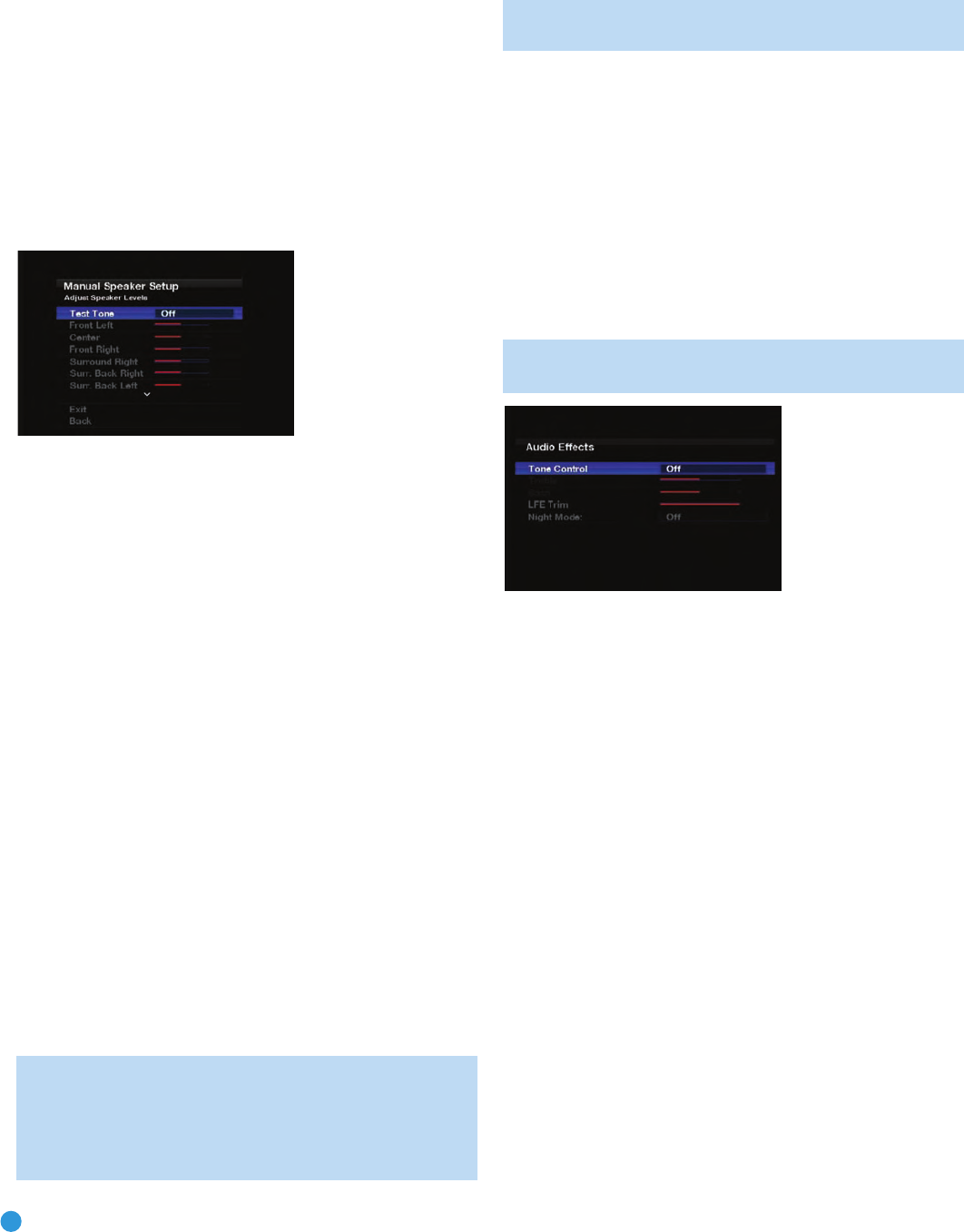
48
48
ADVANCED FUNCTIONS
The best method of setting the output levels is by running the EzSet/EQ
process, as described in the Initial Setup section. If any finer adjustments
are desired, we recommend using the menu system to make the adjust-
ments while playing the AVR’s built-in test tone and measuring the output
using an SPL meter. Less effective would be to measure the output by ear.
Press the AVR Button to display the menu system, and then navigate
to the Speaker Setup line. Press the OK Button to display the Speaker
Setup menu. Select Manual Speaker Setup, press the OK Button, and
then navigate to the Level Adjust line. Press the OK Button to display
the Adjust Speaker Levels menu. See Figure 64.
Figure 64 – Adjust Speaker Levels Menu
All of the speaker channels will appear with their current level settings.
Reset Levels: If you wish to start by resetting all of the levels to their
factory defaults of 0dB, scroll down to this line and press the OK Button.
The levels will be reset.
If you are using an external source to set your output levels, simply
navigate to each channel, press the Set Button and use the
‹
/
›
Buttons
to adjust the level as desired between –10dB and
+
10dB.
If you would like to set your levels using the AVR 254’s internal test
tone, adjust the TEST TONE line as follows.
Test Tone: This line determines whether the test tone is active. To begin
the process of setting the levels, press the OK Button repeatedly to
select the OFF, AUTO or MANUAL setting. Any time you manually move
the cursor out of the channel listings area of the screen, this
setting will automatically change to OFF, stopping the test tone.
When this setting reads AUTO, the test tone will automatically circulate
to all channels, pausing for a few moments at each channel and then
moving to the next channel several seconds later, as indicated by the
highlight bar. You may adjust the level for any channel when the test
tone is paused there by using the
‹
/
›
Buttons. You may also use the
⁄
/
¤
Buttons at any time to move the cursor to another line, and the
test tone will follow the cursor.
When this setting reads MANUAL, the test tone will not move to the
next channel until you use the
⁄
/
¤
Buttons to move it.
NOTE: Setting the channel levels while one surround mode is
active does not carry over to other mode groups. We recom-
mend that after you have set the levels satisfactorily in one
mode, you note the results and change to other surround
modes. For those modes that don’t reflect your level settings,
you may either copy the settings you obtained (as a short cut),
or redo the procedure to determine the correct settings.
When you have finished adjusting the speaker levels, select the SAVE
option so that the settings will not be lost. Record the level settings in
Table A3 in the appendix for future reference.
Audio Effects
Depending on the specific characteristics of your listening room, you
may wish to adjust some of the audio settings, such as tone controls,
to improve performance. Access these settings from the Audio Effects
menu. Press the Audio Effects Button on the front panel or remote,
and the screen shown in Figure 65 will appear. The menu may also be
accessed from the Setup Source menu by pressing the Info Settings
Button and selecting the Audio Effects line.
NOTE: The settings in the Audio Effects menu affect each
source independently.
Figure 65 – Audio Effects Menu
Tone Control: This setting determines whether the treble and bass
controls are active. When it’s off, the tone controls are “flat”, with no
changes. When it’s on, the bass and treble frequencies are boosted
or cut depending upon the tone-control settings. When an analog audio
source is in use and the 2-Channel Stereo surround mode is selected,
setting the Tone Control to “Off” places the unit in analog bypass mode,
with no digital processing of the analog signal.
Treble: Boost or cut the high frequencies by up to 10dB by using the
‹
/
›
Buttons to change the temperature bar setting. The default setting
is 0dB, at the center of the temperature bar.
Bass: Boost or cut the low frequencies by up to 10dB by using the
‹
/
›
Buttons to change the temperature bar setting. The default setting
is 0dB, at the center of the temperature bar.
LFE Trim: This setting may be used to attenuate the loudness of the
subwoofer. The setting defaults to 0dB, which is the maximum. Press the
‹
/
›
Buttons to reduce the level by up to 10dB; the setting will appear
as a negative number.
Night Mode: This setting is used with specially encoded Dolby Digital
programs to compress the signal so that louder passages do not disturb
others, while dialogue remains intelligible.
•
Off: For normal listening.
AVR254om.qxd 3/28/08 12:46 PM Page 48
